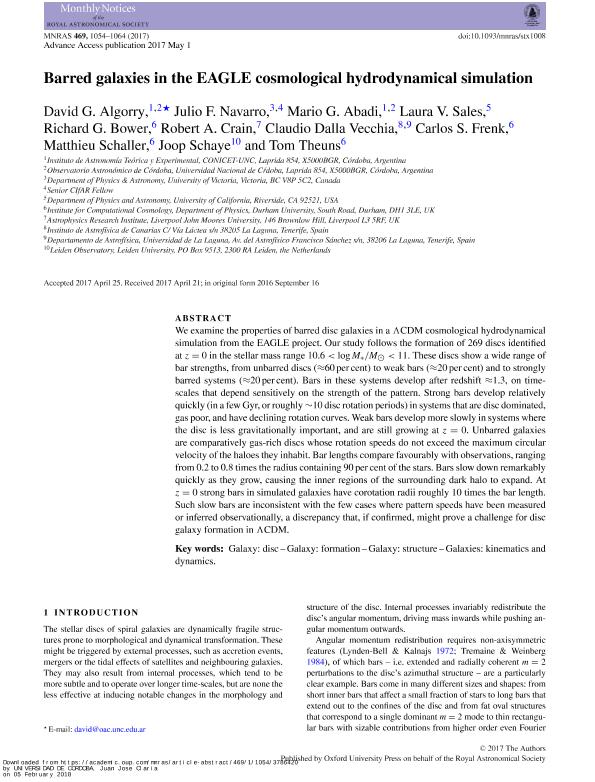Mostrar el registro sencillo del ítem
dc.contributor.author
Algorry, David Gabriel

dc.contributor.author
Navarro, Julio F.

dc.contributor.author
Abadi, Mario Gabriel

dc.contributor.author
Sales, Laura Virginia

dc.contributor.author
Bower, Richard G.
dc.contributor.author
Crain, Robert A.
dc.contributor.author
Dalla Vecchia, Claudio
dc.contributor.author
Frenk, Carlos S.
dc.contributor.author
Schaller, Matthieu
dc.contributor.author
Schaye, Joop
dc.contributor.author
Theuns, Tom
dc.date.available
2018-11-22T18:55:28Z
dc.date.issued
2017-07
dc.identifier.citation
Algorry, David Gabriel; Navarro, Julio F.; Abadi, Mario Gabriel; Sales, Laura Virginia; Bower, Richard G.; et al.; Barred galaxies in the EAGLE cosmological hydrodynamical simulation; Wiley Blackwell Publishing, Inc; Monthly Notices of the Royal Astronomical Society; 469; 1; 7-2017; 1054-1064
dc.identifier.issn
0035-8711
dc.identifier.uri
http://hdl.handle.net/11336/64945
dc.description.abstract
We examine the properties of barred disc galaxies in a ΛCDM cosmological hydrodynamical simulation from the EAGLE project. Our study follows the formation of 269 discs identified at z = 0 in the stellar mass range 10.6 < log M*/M⊙ < 11. These discs show a wide range of bar strengths, from unbarred discs (≈60 per cent) to weak bars (≈20 per cent) and to strongly barred systems (≈20 per cent). Bars in these systems develop after redshift ≈1.3, on time-scales that depend sensitively on the strength of the pattern. Strong bars develop relatively quickly (in a few Gyr, or roughly ∼10 disc rotation periods) in systems that are disc dominated, gas poor, and have declining rotation curves. Weak bars develop more slowly in systems where the disc is less gravitationally important, and are still growing at z = 0. Unbarred galaxies are comparatively gas-rich discs whose rotation speeds do not exceed the maximum circular velocity of the haloes they inhabit. Bar lengths compare favourably with observations, ranging from 0.2 to 0.8 times the radius containing 90 per cent of the stars. Bars slow down remarkably quickly as they grow, causing the inner regions of the surrounding dark halo to expand. At z = 0 strong bars in simulated galaxies have corotation radii roughly 10 times the bar length. Such slow bars are inconsistent with the few cases where pattern speeds have been measured or inferred observationally, a discrepancy that, if confirmed, might prove a challenge for disc galaxy formation in ΛCDM.
dc.format
application/pdf
dc.language.iso
eng
dc.publisher
Wiley Blackwell Publishing, Inc

dc.rights
info:eu-repo/semantics/openAccess
dc.rights.uri
https://creativecommons.org/licenses/by-nc-sa/2.5/ar/
dc.subject
Galaxy
dc.subject
Disc
dc.subject
Bar
dc.subject
Formation
dc.subject.classification
Astronomía

dc.subject.classification
Ciencias Físicas

dc.subject.classification
CIENCIAS NATURALES Y EXACTAS

dc.title
Barred galaxies in the EAGLE cosmological hydrodynamical simulation
dc.type
info:eu-repo/semantics/article
dc.type
info:ar-repo/semantics/artículo
dc.type
info:eu-repo/semantics/publishedVersion
dc.date.updated
2018-10-19T15:36:59Z
dc.journal.volume
469
dc.journal.number
1
dc.journal.pagination
1054-1064
dc.journal.pais
Reino Unido

dc.journal.ciudad
Londres
dc.description.fil
Fil: Algorry, David Gabriel. Consejo Nacional de Investigaciones Científicas y Técnicas. Centro Científico Tecnológico Conicet - Córdoba. Instituto de Astronomía Teórica y Experimental. Universidad Nacional de Córdoba. Observatorio Astronómico de Córdoba. Instituto de Astronomía Teórica y Experimental; Argentina. Universidad Nacional de Córdoba. Observatorio Astronómico de Córdoba; Argentina
dc.description.fil
Fil: Navarro, Julio F.. University of Victoria; Canadá
dc.description.fil
Fil: Abadi, Mario Gabriel. Consejo Nacional de Investigaciones Científicas y Técnicas. Centro Científico Tecnológico Conicet - Córdoba. Instituto de Astronomía Teórica y Experimental. Universidad Nacional de Córdoba. Observatorio Astronómico de Córdoba. Instituto de Astronomía Teórica y Experimental; Argentina. Universidad Nacional de Córdoba. Observatorio Astronómico de Córdoba; Argentina
dc.description.fil
Fil: Sales, Laura Virginia. Consejo Nacional de Investigaciones Científicas y Técnicas; Argentina. University of California; Estados Unidos
dc.description.fil
Fil: Bower, Richard G.. University of Durham; Reino Unido
dc.description.fil
Fil: Crain, Robert A.. Liverpool John Moores University; Reino Unido
dc.description.fil
Fil: Dalla Vecchia, Claudio. Instituto de Astrofisica de Canarias; España. Universidad de La Laguna; España
dc.description.fil
Fil: Frenk, Carlos S.. University of Durham; Reino Unido
dc.description.fil
Fil: Schaller, Matthieu. University of Durham; Reino Unido
dc.description.fil
Fil: Schaye, Joop. Leiden University; Países Bajos
dc.description.fil
Fil: Theuns, Tom. University of Durham; Reino Unido
dc.journal.title
Monthly Notices of the Royal Astronomical Society

dc.relation.isreferencedin
info:eu-repo/semantics/reference/doi/10.1093/mnras/stx1008
dc.relation.isreferencedin
info:eu-repo/semantics/reference/arxiv/https://arxiv.org/abs/1609.05909
dc.relation.alternativeid
info:eu-repo/semantics/altIdentifier/doi/http://dx.doi.org/10.1093/mnras/stx1008
dc.relation.alternativeid
info:eu-repo/semantics/altIdentifier/url/https://academic.oup.com/mnras/article-abstract/469/1/1054/3786420
Archivos asociados
